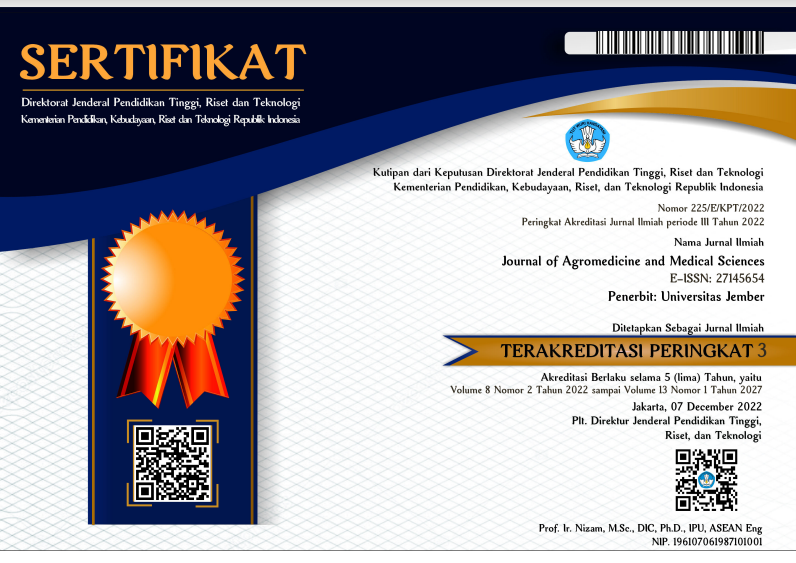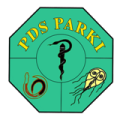Comparison of Student Anxiety Levels in Facing CBT Exams Based on Gender
DOI:
https://doi.org/10.19184/ams.v8i2.31212Abstract
Anxiety is assumed to be an unclear feeling, which causes worry, fear of everything that does not necessarily happen. This anxiety has a psychological impact on a person including it can affect learning achievement. Various studies related to anxiety theory state that gender affects the level of anxiety. Women are considered more prone to anxiety than men. In this study, researchers measured men's anxiety degrees compared to women when taking computer-based tests (CBT) during the pandemic. Exams with this method are suspected to be one of the triggers for anxiety in medical students. The purpose of this study was to compare the level of anxiety of students and female students in facing CBT at Wijaya Kusuma University Surabaya during the pandemic. This study used a cross-sectional approach with a total sampling technique. The total number of respondents was 60 people, 16 men and 44 women. Respondents' anxiety degrees were measured by a measurement scale of depression, anxiety, and stress or what is known as the Depression Anxiety and Stress Scale 21 (DASS-21). The results showed that 12.5% of men and 31.8% of women were in the heavy and very heavy group. The conclusion of this study is that the level of anxiety of women is higher than those men.
Keywords: anxiety levels, medical students, gender, computer based test exam
Downloads
References
Anissa, L. M., Suryani, S., & Mirwanti, R. (2018). Tingkat kecemasan mahasiswa keperawatan dalam menghadapi ujian berbasis computer based test. MEDISAINS, 16(2), 67. https://doi.org/10.30595/MEDISAINS.V16I2.2522
Association of America, A. (2020). Anxiety and Depression. ADAA. https://adaa.org/living-with-anxiety/women/facts
Baig, M., Ali, S. K., Ali, S., & Huda, N. (2014). Evaluation of Multiple Choice and Short Essay Question items in Basic Medical Sciences. Pakistan Journal of Medical Sciences, 30(1), 3–6. https://doi.org/10.12669/pjms.301.4458
Cao, W., Fang, Z., Hou, G., Han, M., Xu, X., Dong, J., & Zheng, J. (2020). The psychological impact of the COVID-19 epidemic on college students in China. Psychiatry Research, 287. https://doi.org/10.1016/J.PSYCHRES.2020.112934
Fitriani, A., Safuni, N., & Zulkarnain, S. I. (2021). THE PERSPECTIVE OF STUDENT OF THE UNIVERSITY TOWARDS EDUCATION POLICY DURING COVID-19 PANDEMIC. Jurnal Transformasi Administrasi, 11(2), 175–184. http://jta.lan.go.id/index.php/jta/article/view/194
Hochlehnert, A., Brass, K., Moeltner, A., & Juenger, J. (2011). Does Medical Students’ Preference of Test Format (Computer-based vs. Paper-based) have an Influence on Performance? BMC Medical Education, 11(1), 89. https://doi.org/10.1186/1472-6920-11-89
Hudiyawati, D., & Prakoso, A. M. (2019). Effectiveness of Cognitive Behavioral Therapy to Reduce Depression, Anxiety and Stress among Hospitalized Patients with Congestive Heart Failure in Central Java. Jurnal Ners, 14(3), 367–373. https://doi.org/10.20473/JN.V14I3.17215
Macauley, K., Plummer, L., Bemis, C., Brock, G., Larson, C., & Spangler, J. (2018). Prevalence and Predictors of Anxiety in Healthcare Professions Students. Health Professions Education, 4(3), 176–185. https://doi.org/10.1016/J.HPE.2018.01.001
Nikpour, G., Kargozar, A., & Ghribzadeh, S. (2021). The Effectiveness of Cognitive Behavioral Therapy (CBT) on Students’ Test Anxiety. Journal of Depression and Anxiety Forecast, 4(2), 1027.
Radeef, A. S., Faisal, G. G., Ali, S. M., & Ismail, M. K. H. M. (2014). Source of stressors and emotional disturbances among undergraduate science students in Malaysia. International Journal of Medical Research & Health Sciences, 3(2), 401. https://doi.org/10.5958/J.2319-5886.3.2.082
Rafique, N., Al-Asoom, L. I., Latif, R., Al Sunni, A., & Wasi, S. (2019). Comparing levels of psychological stress and its inducing factors among medical students. Journal of Taibah University Medical Sciences, 14(6), 488–494. https://doi.org/10.1016/J.JTUMED.2019.11.002
Suryono, S., & Anggraeni, M. D. (2017). METODOLOGI PENELITIAN KUALITATIF DALAM BIDANG KESEHATAN. Yogyakarta, Nuha Medika. http://library.poltekkesjambi.ac.id/opac/detail-opac?id=2977
Tolin, D. F., & Foa, E. B. (2006). Sex differences in trauma and posttraumatic stress disorder: A quantitative review of 25 years of research. Psychological Bulletin, 132(6), 959–992. https://doi.org/10.1037/0033-2909.132.6.959
Twomey, C., O’Reilly, G., & Byrne, M. (2015). Effectiveness of cognitive behavioural therapy for anxiety and depression in primary care: a meta-analysis. Family Practice, 32(1), 3–15. https://doi.org/10.1093/FAMPRA/CMU060
Wagner, U., & Reuß, A. (2019). S3-Leitlinie „Diagnostik, Therapie und Nachsorge maligner Ovarialtumoren“. Forum 2019 34:5, 34(5), 413–415. https://doi.org/10.1007/S12312-019-00671-4
WHO. (2013). Adolescent health. WHO. https://www.who.int/health-topics/adolescent-health#tab=tab_1
Zulkarnain, Z., & Novliadi, F. (2009). Sense of Humor dan Kecemasan Menghadapi Ujian di Kalangan Mahasiswa. Majalah Kedokteran Indonesia, 42(1), 48–54. https://www.researchgate.net/publication/237841775_Sense_of_Humor_dan_Kecemasan_Menghadapi_Ujian_di_Kalangan_Mahasiswa























